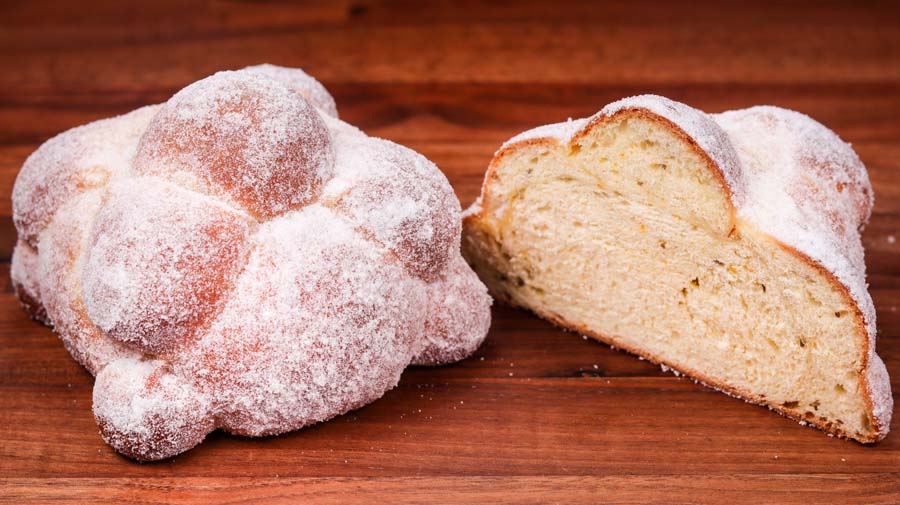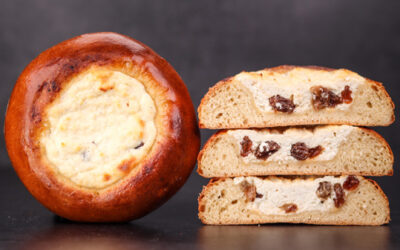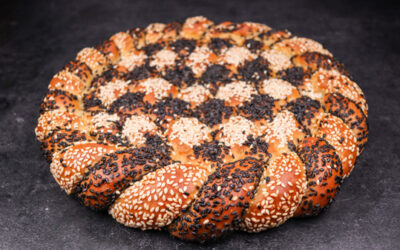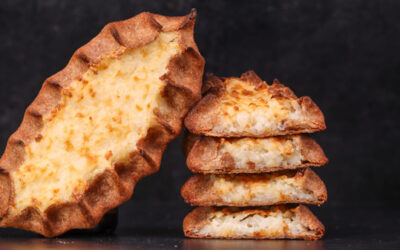Pan de Muertos is a traditional Mexican bread served on Día de Los Muertos. It is a sweetened bread flavoured with anise and orange.
This bread has great significance in Mexican culture. The day of the dead is a holiday where people welcome back the souls of their deceased loved ones.
Each part of the uniquely shaped bread symbolizes something. The round body of the loaf represents the circle of life and death. The ball on the top of the loaf represents the skull of the deceased. And the segmented pieces laid across the loaf represent bones and tears.
Flavoured with anise and orange it has a unique taste. It is enriched with sugar, eggs, and butter. A Mexican brioche of sorts. It is also cold fermented.
After the bread has cooled down from being baked it is brushed with butter and covered in sugar. Sometimes the sugar is coloured. Alternatively, you can skip this and glaze the loaves with egg before you bake them.
Hot chocolate is commonly served alongside this bread, and I have included a recipe for it below.
This recipe makes two medium sized loaves, and the hot chocolate recipe makes two cups. To make more simply multiply all the ingredients.
Watch the video down below for detailed instructions.
Ingredients
For the dough –
250g (8.8oz) white bread flour
100g (3.5oz) egg or two medium sized eggs*
40g (1.4oz) milk*
3g (0.1oz) instant dry yeast or 3.6g (0.12oz) active dry yeast or 9g (0.31oz) fresh yeast
3g (0.1oz) orange oil or extract
1 orange worth of zest
50g (1.75oz) softened butter
30g (1oz) sugar
5g (0.17oz) salt
2g (0.07oz) anise seeds
*To learn more about dough temperature control click here.
For the coating –
70g (2.45oz) melted butter
70g (2.45oz) sugar
For the hot chocolate –
14g (0.5oz) sugar
10g (0.35oz) cocoa powder
4g (0.14oz) vanilla syrup
1g (0.03oz) cinnamon
400g (14oz) milk
60g (2.1oz) dark chocolate
The flour I use has a protein content of 13%. If your flour is weaker, then you may need to lower the hydration.
If you are using active dry yeast, then you may need to let it sit in the water for 10 minutes before adding the other ingredients or else it could take a lot longer to raise the dough.
If you are curious about why the dough contains butter, egg, and sugar, click the links to learn more about the effects those ingredients have on bread dough.
Method
- In a large bowl combine the milk, yeast, salt, sugar, orange oil, orange zest, eggs, and anise seeds. Mix well to dissolve the salt and sugar, and to hydrate the yeast. Add the flour and mix to a dough.
- Tip the dough out on the table and knead for 3 minutes.
- Tear in the butter and knead for 4 more minutes. *Desired dough temperature 25C – 26C (77F – 79F). If your dough is warmer, then it will ferment more rapidly. If it is cooler, then it will take longer. Adjust proofing time accordingly.
- Refrigerate the dough for 1 hour.
- Fold.
- Cold ferment for 12 – 24 hours.
- Divide the dough into 6 pieces. 2 x 20g (0.7oz); 4 x 30g (1oz). Finally, weigh the remaining dough and divide it in half.
- Pre-shape into rounds.
- Cover and leave to rest for 20 minutes.
- Final shaping. *See video.
- Place on a non-stick paper lined tray. Cover and final proof for 2 hours. *During the final hour of fermentation pre-heat the oven to 160C (320F) fan on.
- Bake the loaves for 25 minutes.
- Leave to cool down completely.
- Brush with melted butter and sprinkle with sugar.
- Make the hot chocolate. Combine all ingredients but the chocolate in a small pan. Heat until almost boiling. Stir in the chocolate until melted.
Serve up and enjoy!
Keep in mind that the conditions in each kitchen are different, so fermentation times may vary for you. It is up to the baker to control the bread and react accordingly.
Your oven may be different too, so your baking time may vary.
Watch the video here



